St. James IF Transformers & Superheterodyne
|
St. James IF Transformers & Superheterodyne |
 |
|
Robert T. St. James was experimenting with radio in the early days of the “wireless” age. Bob, as his friends called him, was conducting an amateur radio station for several years prior to World War 1. With his vast knowledge of radio, he was put in command of the First Division Naval Radio School at Harvard. Some 12,000 men passed through his classes during World War 1. It was only natural that a man such as this would become president of his own company after the war; the St. James Laboratories, of Chicago, Illinois. Today, Robert T. St. James is probably best known for his superheterodyne designs, and in particular his very strange and unique glass-enclosed IF transformers. |
 |
|||
 |
|||
|
Above left is an advertisement for the “Red Top” transformers from the Spring, 1925, Citizen’s Radio Call Book. At right is a photo of the transformers (photo from the Internet several years ago). The peak frequency of these transformers is unknown at this time, but they were probably tuned to a frequency below 240 KC. They were advertised to be matched to within 1 KC variation. |
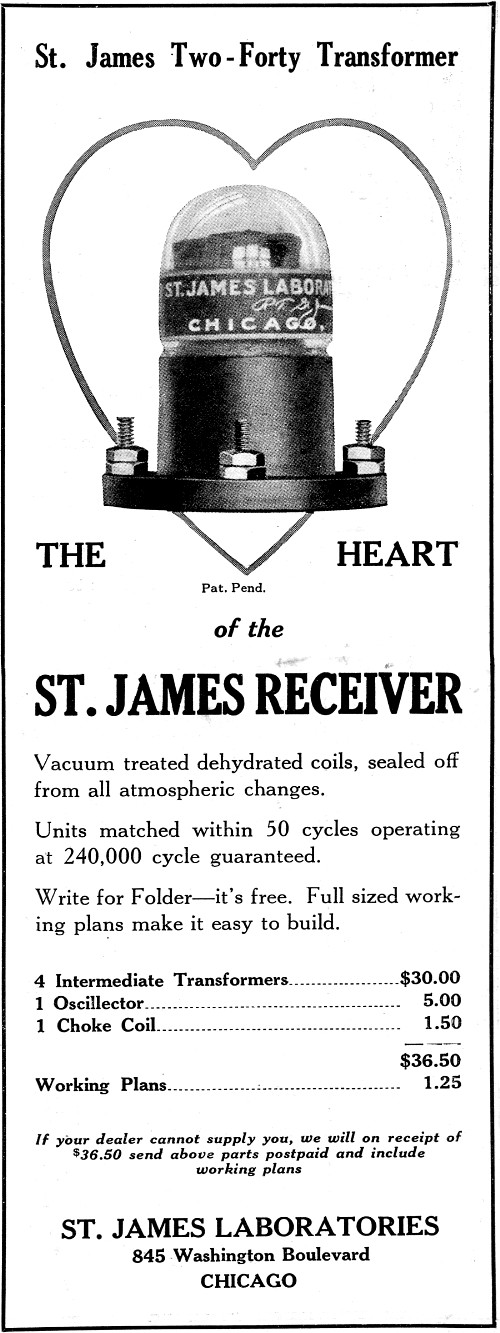 |
|
The above scan is a very nice advertisement for the St. James Two-Forty IF transformer, as copied from the Spring, 1927, Citizen’s Radio Call Book. Note that these transformers are now guaranteed to have a peak frequency of 240 KC - matched to within 50 cycles of each other! |
|
 |
|
The above photo is a plot of the pass band curve of transformer #1. This was produced using a different technique that what was used to get the data for the table. The data in the table is more accurate. |
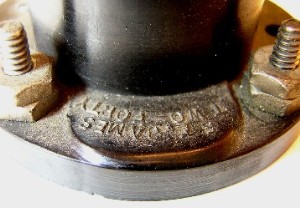 |
|
The base of each transformer is identified as a St. James Two-Forty. |
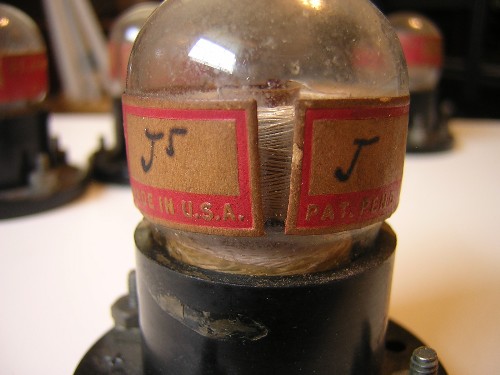 |
|
This is the code(s) that are on each of my transformers. One side of the label has what looks like a capital letter J, and the other side of the label has what looks like a capital letter J raised to the 5th power (or it could be a large capital J with a smaller capital J above and to the right of the first). It seems to be a letter code instead of a number code. Kind of strange letters for sure, but, after all, it’s a code! I would be very interested to hear from anyone who has a St. James Two-Forty transformer, and to know what code is on their transformer(s). |
|
This page was added on August 24, 2013 |
|||||
|
February 14, 2014, update: |
|||||
 |
|||||
|
The above photo shows a couple of old superhets that were once a part of the Billy Richardson collection. The top radio with a meter is a St. James and the bottom radio is a Lincoln. Both of the radios are somewhat rare and both were available. Besides the complete St. James radio, there was also a bunch of St. James IF transformers included with it, so that’s the one that I made a deal with. There was a good variety of St. James IF transformers here and I was very interested in doing some pass band measurements on them. Here are a few particulars of the complete St. James radio: 1. The set works on the standard 1920s superhet circuit. I suspect that it dates from late 1925 to early 1926. |
|
|
|
|
|
|
|
|
 |
|
The above base panel layout is copied from a construction article in the September. 1926, Citizen’s Radio Call Book entitled “The St. James Super with a New Type of Dehydrated Intermediate Frequency Transformer.” The new type of transformer in this article was the short St. James “Two-Forty.” |
 |
|
The schematic diagram of the St. James superhet as copied from the September, 1926, Citizens Radio Call Book. My set is wired very similar to this schematic. However, my set does not have the individual resistors in the filament line of the last two tubes and my set has a variable capacitor across the primary coil of the last IF transformer. |
|
I was a little bit disappointed when I started to investigate the IF transformers in this set. An initial check with a Fluke 77 hand-held meter did not show any continuity on any of the coils! The next step was to connect a General Radio 1862-B megger across the terminals and see what that indicated. The megger indicated continuity all right, and it actually repaired many of the coils! I suspect the magnet wire had bad connections right where the wire was soldered to the lugs and the higher voltage of the megger bridged the bad connections and at least temporarily repaired the transformers. I say temporary because I do not believe it is a good fix. I could not repair the secondary winding on the second transformer this way. The megger has two voltage settings, a 50 volt setting and a 500 volt setting, and the best that I could get the secondary on the second transformer was 20k megohms @ 500 volts. I think the transformer can be repaired by chipping out the tar in the base of the transformer and re-soldering the wires to the lugs. |
|
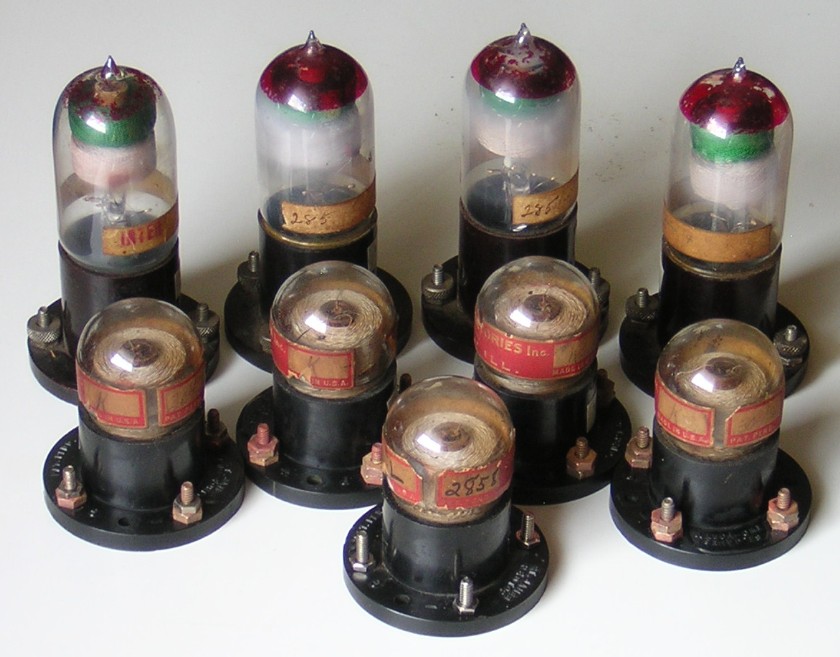 |
|
This is a photo of the nine St. James IF transformers that came in the deal with the St. James superhet. I don’t think the four Red Top transformers were from a complete set because three were marked with a “285” and one was marked “INTER.” All the transformers were marked with the “R. T. St. James” signature, followed by a space that may have had something written but is no longer distinguishable. I believe these Red Top transformers are older than the Red Top transformers in my complete superhet. One of the 285 transformers had a broken glass support for the coils but the wires were still good. The transformer with the broken glass support (on the far right) had a similar problem with the primary coil resistance as the transformers in the complete superhet; a brief connection to the megger repaired it to the point where I could get a brief reading on the Fluke 77 before it indicated open (I suspected that it would work fine in an actual circuit where there were higher voltages involved than in the Fluke 77). |
|
|
The table below records the pass band characteristics and coil resistances of the short Two-Forty transformers. The secondary of all transformers was referenced to A-. |
|
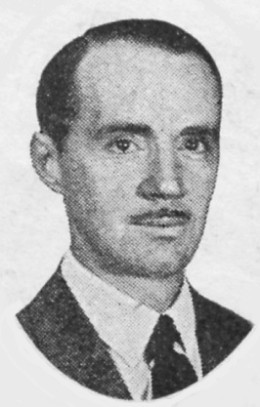 |
|||
|
Robert T. St. James |
|||
|
February 2, 2017 update: |
 |
|
Diagram of the St. James transformer from the patent office. |
||||||||
|
December 23, 2019 Update: |
||||||||
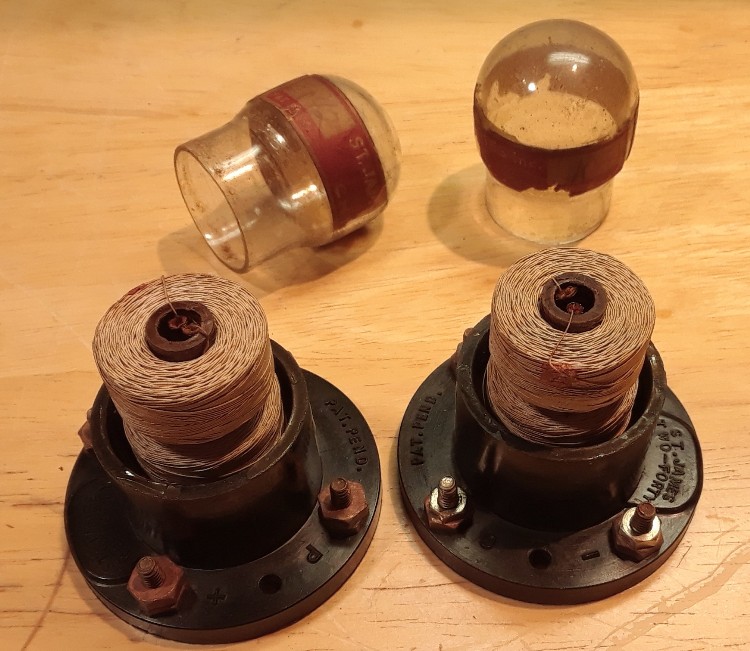 |
||||||||
|
This photo shows two of the Two-Forty transformers with their glass tops removed. I did not remove the glass tops on purpose; the glass was loose and they simply came apart on their own. There is no other part of the glass envelope than what you see in this photo. This type of transformer is not under vacuum. The advertisement for this transformer states that they are “Vacuum treated dehydrated coils.” The advertisement does not claim that they remain under vacuum after manufacture. Note that the coil form is phenolic |
||||||||
 |
||||||||
|
Here is a comparison of the two main types of St. James IF transformers. Note that the coils of the Two-Forty transformer (on the left) are physically larger that the coils of the Red Top transformer (on the right). Though physically larger, the actual inductance of the Two-Forty coils is lower than the inductance of the Red Top coils because the Two-Forty coils are wound with heavier gauge wire. This makes the frequency of the Two-Forty transformers higher than the Red Top transformers. |
||||||||
|
. |
||||||||